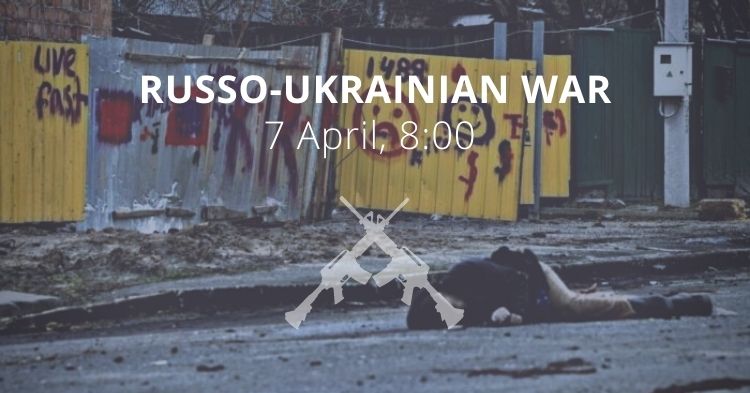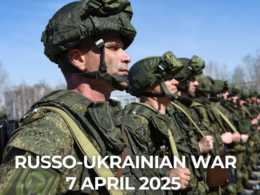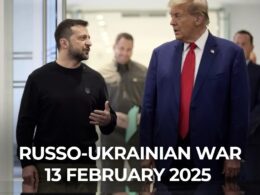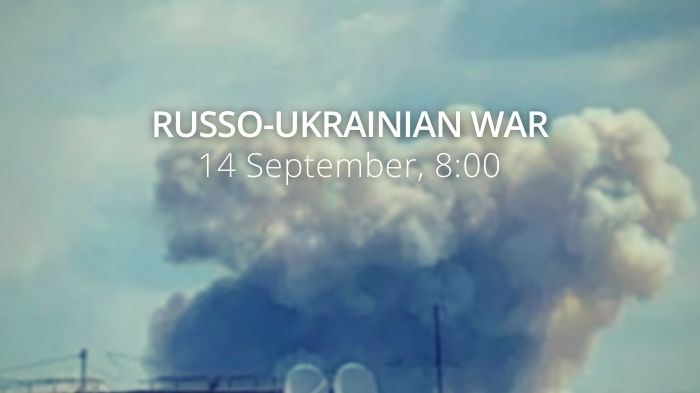Morning report day 43 – April 07
The report is based on media reports, expert analyses, and official information posted online.
Situation
According to information from the General Staff as of 06.00 07.04.2022, supplemented by its 18:00 assessment. The General Staff has reduced its assessments to two a day.
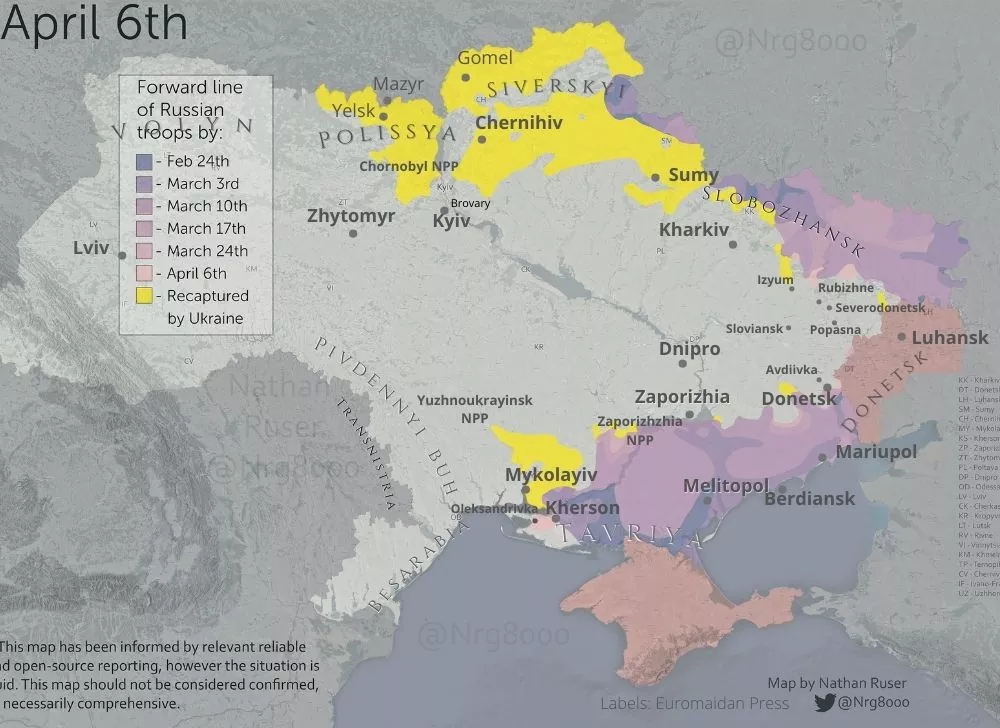
Russian occupiers are regrouping troops and conducting reconnaissance, trying to improve the tactical position of separate units in the Pivdennyi Buh area and gain a foothold on the administrative borders of the Kherson region.
The main effort of the Russian forces' is to conduct offensive operations in order to break through the defenses of the Joint Forces in the Donetsk direction. It is also trying to take full control of the city of Mariupol.
The regrouping of Russian troops and the restoration of combat capability of the Central Military District units deployed to the Bryansk and Kursk oblasts are nearing completion.
Training and relocation of units of the occupying forces of the armed forces of the Russian Federation to the territory of Ukraine are underway. The forces planned to move units of the 38th Separate Motorized Rifle Brigade of the 35th All-Military Army of the Eastern Military District from the territory of the Republic of Belarus to the Belgorod Region. The movement of some units of the Central Military District to this region is also recorded.
In the Volyn and Polissya directions, no significant changes were found in the position and condition of the enemy troops. Units of the Eastern Military District withdrawn to the territory of the Gomel region are completing the regrouping.
The Russian forces continue to be active in the Slobozhansky, Donetsk, Pivdennyi Buh, and Tavriya directions.
In the Slobozhansky direction, the Russian forces continued to blockade the city of Kharkiv and carry out artillery shelling.
https://twitter.com/EuromaidanPress/status/1511999715139031041?s=20&t=MKCETKvvfGNWktIcmyvYjA
- Mostly at night, the Russian occupiers shell the city using multiple rocket launchers, artillery, and mortars. In the area of the city of Izium, the forces did not take active action. By forces of separate divisions of the 20th all-military and 1st tank armies of the Western military district, it carries out regrouping.
- To increase the efficiency of the transfer of military cargo, the forces began to use the railway. The arrival of railway echelons with weapons and military equipment from the Valuyki station (Russian federation) to the Kupiansk railway station (Ukraine) has been recorded.About 90 km N of Kramatorsk and NW of Sievierodonetsk
In the Donetsk and Tavriya directions, the Russian forces continue artillery shelling of the settlement of Popasna. The goal is to engage units of the Armed Forces of Ukraine and resume the offensive on Rubizhne, Nyzhne, and Novobakhmutivka. The Russian occupiers also tried unsuccessfully to break through the defenses of our troops in the area of the settlement of Novotoshkivske.
- The main efforts of the Russian forces are focused on hostilities in the areas of the settlements of Popasna and Rubizhne and the establishment of control over the city of Mariupol. Russian forces are trying to improve the tactical position.
- In the areas of Popasna, Stepny, Novotoshkivske, Rubizhne, Sievierodonetsk, and Solodky, the forces carried out assault operations but were unsuccessful.
- The storming of the city of Mariupol continues, while the forces are actively using aircraft.
- Russian forces carried out artillery shelling in the areas of Kreminna, Pisky, Ocheretino, Rozivka, Novobahmutivka, Novosilka Druha, Marinka and Krasnohorivka.
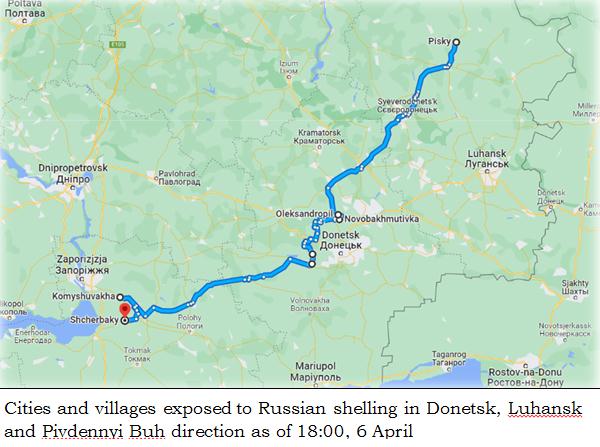
In the Pivdennyi Buh direction, the enemy continues to shell the settlements of Shcherbaki, Komyshuvakha, Novodanylivka, Mala Tokmachka, Huliaipilske, Lukyanivske, Preobrazhenka, and Huliai Pole.
- In the Pivdennyi Buh direction, the Russian enemy is defending previously occupied borders, taking measures to restore the combat capability of its units. Continues to carry out strict filtration measures in the temporarily occupied territories of the Kherson region.
- As a result of the offensive actions of units of the Armed Forces of Ukraine, the enemy lost control over the settlement of Osokorivka.
The Air Force of the Armed Forces of Ukraine has hit three air targets the previous day: a cruise missile, a UAV, and a fighter jet. The Air Force continued to launch missile and bomb strikes on the occupying forces.“
During the last 24 hours, the Ukrainian General Staff has reported on the Russian manning and logistic challenges:
- Some of the withdrawn Russian units are in tent camps in a number of regions of the Russian Federation bordering Ukraine. The Russian servicemen refuse to take part in further hostilities on the territory of Ukraine. The moral and psychological condition of this personnel is low and tends to deteriorate.
- The Command of the Armed Forces of the Russian Federation continues to look for ways to solve the problem of replenishing its units with human resources. Russia’s military commissariats have stepped up work with conscripts who have been discharged from military service since 2012 and have military specialties of a driver, mechanic-driver, scout, and junior commanders. The official reason for the call to the military registration and enlistment offices is to hold a training meeting on the specified military specialties for 3 months. Also, on the territory of the so-called Transnistrian-Moldavian republic, appropriate propaganda work is being carried out with the population who has Russian citizenship.
Russian Air Force evades Ukrainian air defense, Ukrainska Pravda reports, citing the Ukrainian Air Force.
"As we reported earlier, the forces have changed their aerial warfare tactics: it has avoided entering our air defence area and has stayed away from direct contact with fighters. Instead, they have launched missile strikes from the air, including from Belarusian airspace."
Russian forces are gathering, offensive is expected in 3-4 days, Ukrainska Pravda reports, citing Serhiy Haidai, Head of the Luhansk Regional Military Administration on Wednesday. "We are observing the constant arrival of new Russian forces, both equipment and personnel. I think, in 3-4 days, once they complete the relocation of all reserves, they will try to conduct an offensive," he said. However, the Armed Forces of Ukraine are ready to fight back.
As of Thursday 07.04.2022, the approximate losses of weapons and military equipment of the Russian Armed Forces from the beginning of the war to the present day:
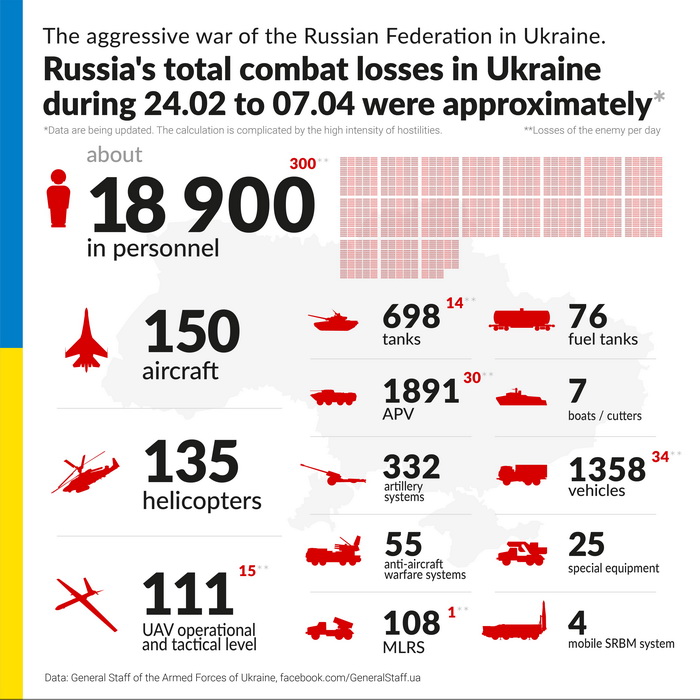
- personnel – more than 18900 people (+300),
- tanks – 698 units (+14),
- armored combat vehicles – 1891 units (+30),
- artillery systems – 332 (no change),
- multiple rocket launchers – 108 (+1)
- air defence means – 55 (no change),
- aircraft - 150 (no change),
- helicopters - 135 (no change),
- automotive technology – 1358 (+34),
- vessels/boats - 7 units (no change),
- fuel and lubricant tanks – 76 (no change),
- UAV operational and tactical level – 111 (+15)
- Special equipment – 25 (no change)
- Mobile SRBM system – 4 (no change)
Humanitarian
"Evacuate if you can": authorities tell residents of Donetsk and Luhansk oblasts, Ukrainska Pravda reports. On Wednesday 6 April, Deputy Prime Minister Irina Vereshchuk and the military administrations have encouraged residents of Donetsk and Luhansk Oblasts to evacuate while they still have the chance.
According to UNHCR
4,278,789 refugees have been registered as of April 5. The UN says that so far Poland has taken in 2,490,447 refugees, Romania 654,825, the Republic of Moldova 399,039, Hungary 398,932, Russia 350,632 (no changes since March 29), Slovakia 302,417 and Belarus 17,317. Among those who fled Ukraine are also Ukrainian nationals with dual citizenship. An additional 113,000 people moved to the Russian Federation from the Donetsk and Luhansk regions between 21 and 23 February.
OHCHR recorded 3,776 civilian casualties in Ukraine as of midnight of April 5. 1,563 were killed (including 130 children) and 2,213 injured (including 188 children).
167 children were killed, and 297 children injured, the Office of the Prosecutor General of Ukraine reports that as of April 7.
On April 6 agreed humanitarian corridors orchestrated the evacuation of 4,892 people. According to the Deputy Prime Minister and Minister of Reintegration of Temporarily Occupied Territories of Ukraine:
“3686 people arrived in Zaporizhzhia today through humanitarian corridors from Mariupol and Berdiansk by their own transport and evacuation buses. There are 1171 of them from Mariupol. 2515 people arrived from the cities of the Zaporizhzhia Oblast: Pology, Vasylivka, Berdiansk, Melitopol and Hulyaypole. 1,206 people were evacuated from the cities of Lysychansk, Sievierodonetsk, Rubizhne, Kreminna and the village of Hirske in the Luhansk Oblast.”
Environment
Losses from Russian invasion: $68 billion direct losses and $600 billion in indirect losses, Ukrainska Pravda reports. As of 1 April, Ukraine's direct losses from Russian military actions amount to at least $68 billion, and indirect losses amount to $600 billion, Iryna Vereshchuk, Deputy Prime Minister, Minister for Reintegration of the Temporarily Occupied Territories of Ukraine, said at a briefing.
"According to preliminary estimates, at this moment at least 26,000 square metres of living space, 533 educational institutions, 196 health care facilities, 300 kindergartens, 8 civilian airports, 10 military airfields, 129 factories and enterprises, over 22,000 kilometres of roads, 226 bridges and bridge crossings have been damaged, wrecked and destroyed in Ukraine since 24 February.
Direct losses of physical infrastructure amounted to at least $68 billion as of 1 April, according to calculations by experts at the Kyiv School of Economics, carried out in close cooperation with the Ministry of Reintegration and the government team under the ‘Russia Will Pay’ initiative. The indirect losses of the economy so far amount to $600 billion. Unfortunately, they are increasing every day."
Liberation of Irpin, Bucha, Kyiv Oblast....
Death, destruction, horror left behind by the russian invaders.#PutinIsaWarCriminal #RussiaWarCrimesPhotos: Andriy Dubchak (Donbas Frontliner) pic.twitter.com/1iuD1qMnnp
— Euromaidan Press (@EuromaidanPress) April 3, 2022
Iryna Vereshchuk stressed that Russia, as the aggressor state, must fully compensate for all these losses and will be held accountable for what it has done.
Legal
The occupiers begin to burn Mariupol’s dead in mobile crematoria, Ukrainska Pravda reports, citing the City Council. Russian mobile crematoria in partially occupied Mariupol, Donetsk region, are burning the bodies of murdered and killed city residents.
"The killers are covering their tracks. Russian mobile crematoria have started operating in Mariupol. After widespread international recognition of the genocide in Bucha, the Russian leadership has ordered the destruction of any evidence of crimes by its army in Mariupol. One week ago, cautious estimates put the death toll at 5,000. But given the size of the city, the catastrophic destruction there, the duration of the blockade and the fierce resistance, tens of thousands of civilians from Mariupol could have fallen victim to the occupiers.”

According to the General Staff of Ukraine, the Russian occupiers continue to use violence against civilians in the temporarily occupied territories. The population of Mariupol is being forcibly deported to the temporarily occupied districts of the Donetsk oblast.
Russian troops have deported patients & doctors of Mariupol's hospital #4 to Russia; armed men "in the form of an ultimatum" ordered them to get in the bus; their fate unknown
In all, 40,000 Mariupolites have been deported - city administration https://t.co/byKGM7aqYM
— Euromaidan Press (@EuromaidanPress) April 7, 2022
4820 crimes of aggression and war crimes, and 2463 crimes against national security were registered
as of April 7. 928 educational establishments are damaged as a result of shelling and bombings, 84 of them are destroyed fully.
Support
US sending Ukraine tactical communications gear in new $300M package, the DefenseNews reports. A potentially $300 million batch of aid eventually bound for Ukraine will include unmanned aerial systems, some tactical secure communications, night vision devices and optics, medical supplies, commercial satellite imagery services, ammunition, and machine guns.
“Unlike presidential drawdown, USAI is an authority under which the United States procures capabilities from industry rather than delivering equipment that is drawn down from our own stocks, Kirby said. So, this announcement represents the beginning of a contracting process that will provide these new capabilities.”
The UK will provide Ukraine with armored vehicles, Ukrainska Pravda reports, citing The Times. The British Ministry of Defense is considering options for sending armored vehicles such as Mastiff and cars like the Chakal, which can be used as reconnaissance or long-range patrol. "Britain will announce further support (for Ukraine - ed.), Including anti-tank and anti-aircraft missiles, in the coming days," The Times reported.
The US Senate has approved a bill that provides for a lease for Ukraine, the European Truth reports. Late Wednesday, the US Senate unanimously passed a bill to restore a program of World War II, which will allow President Joe Biden to more effectively send weapons and other supplies to Ukraine amid Russia's invasion. The Lend-Lease program, created during World War II, was considered a turning point in the war because it allowed the United States to quickly replenish Allied supplies without time-consuming procedural obstacles. The document, known as the Ukraine Democracy Defense Lend-Lease Act of 2022, will speed up the transfer of important military equipment and other critical supplies to Ukraine by reducing bureaucratic red tape. It allows you to de facto donate equipment with provisions that provide that the recipient countries will pay the cost to the United States later.
The United States, G7 and EU Impose Severe and Immediate Costs on Russia, according to a statement from the White House. Experts predict Russia’s GDP will contract up to 15 percent this year, wiping out the last fifteen years of economic gains. Inflation is already spiking above 15 percent and is forecast to accelerate higher. More than 600 private sector companies have already left the Russian market. Supply chains in Russia have been severely disrupted. Russia will very likely lose its status as a major economy, and it will continue a long descent into economic, financial, and technological isolation. Today, the United States is announcing the following actions:
- Full blocking sanctions on Russia’s largest financial institution, Sberbank, and Russia’s largest private bank, Alfa Bank.
- Prohibiting new investment in the Russian Federation.
- Full blocking sanctions on critical major Russian state-owned enterprises.
- Full blocking sanctions on Russian elites and their family members
- The US Treasury prohibited Russia from making debt payments with funds subject to US jurisdiction.
The UK imposes sweeping new sanctions to starve Putin's war machine, according to a statement from The Foreign Secretary. Key sanctions announced today include:
- asset freezes against Sberbank and Credit Bank of Moscow.
- an outright ban on all new outward investment to Russia.
- by the end of 2022, the UK will end all dependency on Russian coal and oil, and end imports of gas as soon as possible thereafter.
- action against key Russian strategic industries and state-owned enterprises. This includes a ban on imports of iron and steel products, a key source of revenue.
- targeting a further eight oligarchs active in these industries
New developments
"We Cannot Rest till Ukraine prevails, and Vladimir Putin fails". European Truth reports, citing the UK Foreign Secretary. “If Putin was serious about peace talks, he would have called a halt to the shelling of innocent civilians and pulled his soldiers out of Ukraine for good. We can, and must, do more to make him think again. We must ensure Putin is never able to threaten Ukraine again.”
Hungary's Orban says he asked Putin to apply ceasefire in Ukraine, Reuters reports. Hungarian Prime Minister Viktor Orban said he had invited President Putin for talks in Hungary to be held with the Ukrainian and French presidents as well as the German chancellor. He said Putin's response was "positive", but that he said this would carry conditions. "I suggested to President Putin that he should announce a ceasefire immediately," Orban told a news conference, adding that it was Putin who called him. He said European leaders had not yet been informed of the proposal.
Zelensky listed which countries are ready to discuss security guarantees for Ukraine, Ukrainska Pravda reports. " He said, there has been no meeting between Ukraine and countries that guarantee its security (those we see as guarantors and those that want to support). It must be the United States, the United Kingdom, Türkiye, Poland, Germany, France, and Israel - these are not all guarantors, but I have named those countries that are ready to come and discuss the list of security guarantees.
Russia is increasingly disseminating its “US-Ukrainian biological and chemical” disinformation narrative.
- The United States carried out research work at biological laboratories in Ukraine searching for conditions on how viruses may inflict economic damage on other countries, Chief of Russia’s Nuclear, Biological and Chemical Protection Troops Igor Kirillov said, TASS
- According to available data, there is emergency destruction of evidence of breaches of Articles 1 and 4 of the BTWC in Ukrainian biological laboratories. Back in early February, the most valuable samples of biomaterials were taken from Odesa to the United States by the US military transport aircraft, and laboratory equipment was sent to Lviv, TASS
- "We suspect that the regime in Kyiv, relying on support from its Western handlers, may explode a certain amount of chemicals in communities in the Kharkiv Oblast to blame this on Russia’s artillery and other strikes," he said. "We have cautioned them against this type of scenario and warned that the tricks they used before will not work," TASS
Assessment
On the War
The Institute for the Study of War has made the following assessment as of Tuesday 06 April:
“Russian forces continued to redeploy forces to the Izium-Sloviansk axis and eastern Ukraine in the past 24 hours and did not secure any major advances. Russian forces completed their withdrawal from Sumy Oblast, and Russian forces previously withdrawn from northeastern Ukraine continued to redeploy to Belgorod, Russia, for further deployment to Izium or Donbas. The Ukrainian military reported that Russia plans to deploy elements from the Kyiv axis to Izium, but these units will not likely regain combat effectiveness for some time.
Russian forces may be preparing for a larger offensive in Donetsk and Luhansk Oblasts in the coming days, but are unlikely to generate the combat power necessary to break through Ukrainian defences in continuing frontal assaults. Ukrainian officials and pro-Russian Telegram channels both reported additional Russian equipment arriving in Donbas from an unspecified location in preparation for a renewed offensive. Russian forces continued assaults in Mariupol, and we cannot confirm concrete control of terrain changes in the city. Russian forces continued offensive operations along the Izium-Sloviansk axis but did not make any major territorial gains.
Key Takeaways
- Russian forces with heavy air and artillery support continued assaults on Ukrainian positions in Mariupol in the past 24 hours.
- Russian and proxy forces in eastern Ukraine are likely attempting to consolidate forces and material for an offensive in the coming days.
- Russian forces continued offensive operations from Izium towards Sloviansk but did not make any major territorial gains.
- Ukrainian forces conducted successful counterattacks towards Kherson from both the north and west.
- Russian forces completely vacated Sumy Oblast.
- Russian General Officers are reportedly instructing commanders to severely restrict internet access among Russian personnel in an attempt to combat low morale.
- The US and NATO should take a strong stance on any Russian threat to use its military forces in Transnistria, the illegally Russian-occupied strip of Moldova bordering Ukraine.
Ukrainian Military Intelligence reported increasing Russian censorship in an effort to combat growing morale problems among Russian troops. Ukraine’s GUR reported that Russian officers are intensifying censorship of their troops and restricting access to the internet due to low morale. The GUR claimed that Russian commanders complain about increasing Ukrainian influence over the information consumed by Russian soldiers. The GUR claimed to have intercepted an extract from an order issued by the Deputy Commander of the Western Military District for military and political work, which blamed low Russian morale on the internet and social media. The document reportedly instructs Russian officers to either ban or severely censor all messages received by personnel, as well as access to the internet. Draconian measures to restrict access to information among Russian personnel will likely further exacerbate low morale and desertion rates.”
Ukraine war likely to last for years, only US troops could have stopped the invasion, the New York Post reports, citing General Mark Milley, chairman of the Joint Chiefs of Staff.
Gen. Mark Milley, chairman of the Joint Chiefs of Staff, said the conquest of Ukraine had been a “long-standing objective” of Russian President Vladimir Putin. “Candidly, short of the commitment of US forces into Ukraine proper, I am not sure he was deterrable,” Milley told the House Armed Services Committee while testifying alongside Defense Secretary Lloyd Austin.
“This has been a long-term objective of his that goes back years. I think the idea of deterring Putin from invading Ukraine — deterring him by the United States — would have required the use of US military forces and would have risked armed conflict with Russia, which I wouldn’t advise.”
Milley’s admission contradicted rhetoric from the Biden administration about the hoped-for effect of sanctions against Russia prior to the Feb. 24 invasion. As late as Feb. 22, White House press secretary Jen Psaki told reporters, “Sanctions are not an end to themselves. They serve a higher purpose. And that purpose is to deter and prevent. They’re meant to prevent and deter a large-scale invasion of Ukraine that could involve the seizure of major cities, including Kyiv.” ME: On March 24, President Biden stressed that sanctions were never meant to deter, but “to increase the pain to the point that the Russian economy is crippled, and President Putin is no longer able to continue the war in Ukraine”
When asked by Rep. Bill Keating (D-Mass.) how long he thought the war could last, Milley responded that it was “hard to tell.”
“It’s a bit early, still. Even though we’re a month-plus into the war, there is much of the ground war left in Ukraine,” he added. “But I do think this is a very protracted conflict, and I think it’s at least measured in years. I don’t know about a decade, but at least years for sure.
“This is a very extended conflict that Russia has initiated,” Milley went on, “and I think that NATO, the United States, Ukraine and all of the allies and partners that are supporting Ukraine are going to be involved in this for quite some time.”
Despite Russia’s economy being rocked by Western sanctions, Milley warned that Moscow “retains a large and varied nuclear capability to threaten the United States and our allies and partners, and we have heard very provocative rhetoric concerning Russia’s nuclear force alert levels from Russian senior leaders.”
Days after giving the invasion the green light, Putin ordered his country’s nuclear weapons to be placed on high alert due to what he called the West’s “aggressive statements” in defense of Ukraine.
“Western countries aren’t only taking unfriendly actions against our country in the economic sphere, but top officials from leading NATO members made aggressive statements regarding our country,” Putin said in remarks carried on state television on Feb. 27.
Russia sits on the world’s largest stockpile of nuclear weapons — nearly 6,000 warheads — which includes missiles capable of striking the US mainland, according to the Bulletin of Atomic Scientists.
With Russia’s assault on Ukraine, Milley said, the US is “facing two global powers, China and Russia, each with significant military capabilities, both who intend to fundamentally change the rules-based current global order.”
Assessment by Hans Petter Midttun
I disagree with Gen. Mark Milley, chairman of the Joint Chiefs of Staff, statement that “short of the commitment of US forces into Ukraine proper, I am not sure Putin was deterrable”. I believe that to be false unless the statement only refers to the last couple of months leading up to the full-scale war. Seen in the context of the 15 years that have passed since President Putin’s speech at the Munich Security Conference, the 14 years that have gone by since Russia’s attack on Georgia and the 8 years that have passed since it began its active war in Ukraine, the USA, NATO, and the EU has wasted several opportunities to curb Russia.
I believe Russia and President Putin is surprised by the strong and comprehensive Western response to its assault on Ukraine on 24 February. Most probably he did not expect the USA and Europe to come together and jointly introduce the most comprehensive package of sanctions ever in history. Russia did not expect to be subjected to what it describes as a Western total, economic, information, and cultural war. Most likely Putin did not expect the USA and Europe to supply Ukraine with modern, high-tech weapons on the scale we have witnessed for more than 2 months already, either. Neither did he expect Europe to slowly turn its back to Russian energy.
If the assessment is correct – if President Putin was indeed surprised big time – it is also an indication of our failure to demonstrate the unity and resolve - will and ability – to restrict Russia’s conceived freedom of action. Russia has developed and acted according to an increasingly more aggressive foreign policy believing that the West was weak, and not willing to defend shared values and principles.
What could we have done to deter the war in Ukraine?
Response when challenged
During the last 15 years of aggressive Russian foreign policy, involving both conventional and hybrid wars, war crimes, assassinations, an attempted coup, election and referendum meddling, cyber-attacks, active espionage and an increasingly more aggressive military posture, the international community has responded with “words of concern”. Except for limited sanctions, NATO and the EU have hardly responded in any real-time, direct and practical manner. There have been barely any consequences. On the contrary, we have continued the reduction of our national and collective force structures, while we talked about reset of relationships.
While we immediately responded to any incident or provocation during the Cold War, we have hardly responded at all during the last 15 years.
Response to the Russian attack on Ukraine, starting in 2014
“Words of concern” should have been followed up with clear strategic signalling and associated practical measures. These include escalating sanctions, giving Russia a clear deadline to respond to the international community’s demand for it to withdraw from Ukrainian territory. Failing to act, sanctions should have been strengthened every 2-3 months until we reached the present level (but 6 years earlier).
We should not at least have supported Ukraine’s effort to reestablish deterrence and close critical military vulnerabilities. Failing to provide defence aid, along with the declaration that NATO would not engage militarily, were strategic blunders that ensured Russian freedom of action.
Under the auspice of military diplomacy, and after being invited by Ukraine as a host nation, the Alliance could have stationed combat aircraft and air defence on Ukrainian airports, troops on Ukrainian bases and warships in Ukrainian ports. These would have functioned as tripwires in the same manner as NATOs Enhanced Forward Presence in the Baltic countries and Poland. Russia would have run the risk of attacking NATO forces and triggering a wider conflict. Most importantly still, it would have been a demonstration of NATO's resolve without engaging in battle.
Response to Russian Hybrid War against the West
Five months before the Russian invasion of Ukraine, the European Parliament assessed Russia to be a long-term threat to European security. It stated that “the current Russian regime is threatening peace and security in Europe by the aggressive behaviour in its foreign policy, including but not limited to: large-scale military exercises and military build-ups; the illegal and violent occupation and annexation of Crimea; the violation of the territorial integrity and the destabilisation of Ukraine, Georgia and the Republic of Moldova; support for frozen conflicts and its failure to respect ceasefire agreements in Georgia and Ukraine; alleged acts of terrorism on the territory of the EU Member States such as Czechia; cyberattacks and attacks on sensitive infrastructure in the EU Member States; violations of international law; election interference; and violations of the sea and air space of countries in the Baltic Sea and the Black Sea regions.”
The European Parliament further stressed that Russia is implementing strategies of hybrid warfare against the EU and its Member States while underlining “that these acts are of a particularly destabilising and dangerous nature as they blur the lines between war and peace, destabilise democracies and sow doubt in the minds of target populations.”
While the assessment from September 16, 2021, is relatively recent, the actions leading up to it are not.
The USA and the EU have been exposed to the Russian aggressions since the very start of its war against Ukraine in 2014. They have, however, never properly reacted to the increasingly more aggressive Russian foreign policy. Instead of the Wales Summit pledge from 2014 to increase defence budgets and (maybe) meet NATO targets before 2024, member countries should have responded with an immediate and urgent strengthening of both budgets, force, and command structures.
Our military posture should have been adapted to the new security environment 8 years ago. It would have served as a demonstration of “will and ability” to ensure deterrence, and consequently, to avoid war altogether.
I, therefore, disagree with General Mark Milley, chairman of the Joint Chiefs of Staff, statement that “short of the commitment of US forces into Ukraine proper, I am not sure Putin was deterrable”. Starting a full-scale war in Ukraine, Russia made its biggest strategic blunder in recent history based on the false assumption that we would not respond forcefully. Our actions came most likely as a surprise to President Putin, demonstrating a complete failure in Western dialogue, diplomacy, and deterrence.
Moving forward, we mustn’t continue doing the same mistakes. It is time to introduce the military options and establish our red lines. A humanitarian intervention, including an UN-mandated No-Fly Zone, must be introduced to cut short the war and its many horrific consequences.
If we accept General Milley’s assessment of the timeline, the world is indeed in for an energy and food crisis, and a consequential economic recession. It is time for leaders to lead.

